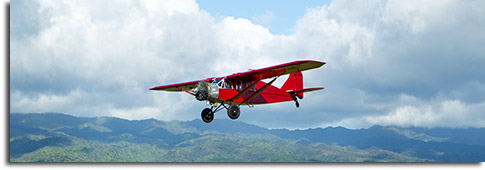This story begins in 1929 when the Inter-Island Steam Navigation Company in the Territory of Hawaii decided to inaugurate airline service between the islands. Thus was born Inter-Island Airways. The fledgling airline’s first airplanes were to be twin-engine, eight-passenger Sikorsky S–38 Amphibions (Sikorsky’s preferred spelling).
The new airline was headed by Stanley Kennedy, an astute businessman who recognized that selling aviation to a public accustomed to travel by sea would require demonstrating the safety and comfort of travel by air. To help the people of Hawaii feel more comfortable about flying, the company purchased a Bellanca CH–300 Pacemaker, NC251M. It was equipped with a 300-horsepower Wright Whirlwind J-6E radial engine, a more powerful version of the 237-horsepower J-5C installed two years earlier in the Spirit of St. Louis.
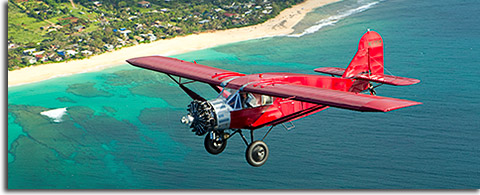
A Bellanca was chosen because it had earned a proud and dominant reputation.
The Sicilian-born Giuseppe Mario Bellanca emigrated as a young man from Italy to the United States in 1911. He soon taught himself to fly in an airplane of his own design that he built in his basement. He later founded the Bellanca Flying School in New York. One of his students was Fiorello LaGuardia, who in turn taught Bellanca to drive.
The Bellanca Pacemaker descended from a long line of record-breaking monoplanes that were considered to be some of the best designs of the pioneer era. During the 1920s and 1930s, Bellancas won races and broke records. These included the first nonstop flight across the Pacific Ocean in 1931, from northern Japan to Wenatchee, Washington, in 41 hours, 15 minutes. The aircraft, a Bellanca named Miss Veedol, was flown by Clyde “Upside Down” Pangborn and his co-pilot, Hugh Herndon Jr. (The wings of the Bellanca were filled with ping-pong balls in the hopes they would help keep it afloat in case of a ditching.)
Charles Lindbergh was impressed with Bellanca aircraft and wanted to use the Model WB–2 for his planned flight to Paris. Bellanca’s board chairman, Charles Levine, agreed to sell him the airplane but insisted on providing the pilot for the trans-Atlantic flight. This was not quite what young Lindbergh had in mind, so he instead arranged to purchase an airplane from the relatively unknown Ryan Aeronautical Company in San Diego. Only two weeks after Lindbergh’s flight, however, Clarence Chamberlin and Levine broke Lindbergh’s record by flying a Bellanca WB–2 named Columbia from New York to Eisleben, Germany (300 miles farther than Lindbergh had flown).
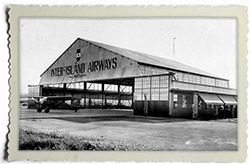 Inter-Island Airways’ first airplane, NC251M, rolled off Bellanca’s assembly line in New Castle, Delaware, on September 17, 1929. It was flown to California, shipped to Hawaii, reassembled in Honolulu, and put to work carrying passengers on 10- to 20-minute sightseeing flights along the south shore of Oahu. Tickets initially sold for $3 per person (approximately $40 in 2011 dollars). Between 1929 and 1933 the Bellanca carried thousands of people without incident from John Rodgers Field (now Honolulu International Airport). For most it was their first flight.
Inter-Island Airways’ first airplane, NC251M, rolled off Bellanca’s assembly line in New Castle, Delaware, on September 17, 1929. It was flown to California, shipped to Hawaii, reassembled in Honolulu, and put to work carrying passengers on 10- to 20-minute sightseeing flights along the south shore of Oahu. Tickets initially sold for $3 per person (approximately $40 in 2011 dollars). Between 1929 and 1933 the Bellanca carried thousands of people without incident from John Rodgers Field (now Honolulu International Airport). For most it was their first flight.
One reporter wrote that, “[flying in] the Bellanca is like [riding on] a train,” an analogy that likely didn’t mean much to the people of Hawaii.
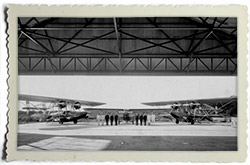 Inter-Island Airways began scheduled service using its first Sikorsky Amphibion on November 11, 1929, with a round-trip flight between Honolulu and Hilo with stops in Molokai and Maui.
Inter-Island Airways began scheduled service using its first Sikorsky Amphibion on November 11, 1929, with a round-trip flight between Honolulu and Hilo with stops in Molokai and Maui.
By 1933 and after having flown almost 2,000 hours, the Bellanca had served its purpose and was sold to Star Air Service in Alaska. There it began life as a hard-working bush plane on wheels, skis, and floats. Star eventually morphed into what is now known as Alaska Airlines.
In 1941 and concurrent with the introduction of its Douglas DC–3s, Inter-Island Airways changed its name to Hawaiian Airlines. All but one of its aircraft were damaged during the attack on Pearl Harbor.
John Pike of Oregon City, Oregon, bought the old Bellanca Pacemaker as a wreck in 1967 for $150. He and his father spent 13 years restoring the airplane and flew it for many years thereafter. By 2002, however, the fuselage was ravaged by corrosion, and Pike began another restoration.
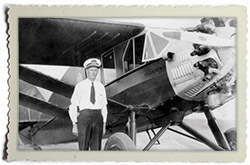 In January 2009 Pike was contacted by Hawaiian Airlines. The airline wanted to purchase its original airplane and use it as part of the airline’s eightieth anniversary celebration later that year. Pike agreed to the sale.
In January 2009 Pike was contacted by Hawaiian Airlines. The airline wanted to purchase its original airplane and use it as part of the airline’s eightieth anniversary celebration later that year. Pike agreed to the sale.
With only months available to complete the restoration, Joe Pritchard of Arlington, Washington, was selected to supervise and coordinate the several other artisans who were recruited to participate in the restoration process. The expedited project was completed in time, and the beautifully restored airplane was available to carry passengers in Honolulu on Hawaiian Airlines’ eightieth anniversary, November 11, 2009.
My checkout in this special airplane was unusual in the sense that my instructor was Hawaiian Airlines Chief Executive Officer Mark Dunkerley. (I never even met the CEO of the airline I worked for.) Dunkerley also is a devoted, 2,000-hour—most of it is in taildraggers—general aviation pilot and owns a gorgeous Giles G–202, a two-place, Unlimited-class aerobatic airplane similar to but smaller than the Extra 300. When not running an airline, you can find him pulling Gs high in the sky above Oahu. Before helping to rescue Hawaiian Airlines from fiscal difficulty, Dunkerley, a British import, was the chief operating officer of Sabena, the national airline of Belgium.
“The airplane isn’t a perfect restoration,” Dunkerley says. “The seats are from an ancient Cessna. Also, the aircraft now has a larger rudder, a modification made to the airplane some years ago when a 450-horsepower Pratt & Whitney engine replaced the original 300-horsepower Wright Whirlwind. We believe that our Bellanca is the only airworthy survivor of its type.”
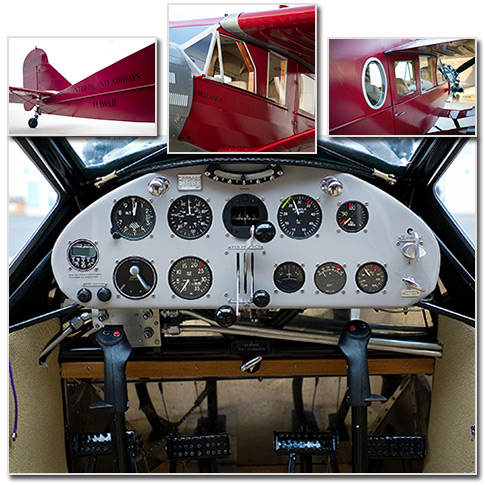
Some obvious concessions were made to enable the airplane to operate at an international airport. It is nice, though, that flat-box avionics were mounted inconspicuously on the left sidewall next to the pilot’s seat so as not to disturb the ambiance of the 1929 instrument panel.
Typical of the era, the Pacemaker has fabric-covered wooden wings and a fuselage constructed of welded chrome-moly steel tubing.
Giuseppe Bellanca was regarded by his peers as an airfoil wizard with a talent for developing efficient, high-lift wings. Bob Munro, a founder of Kenmore Air, a world-class seaplane facility near Seattle that operated the airplane for some years, said that when NC251M was on floats, you could take off without first having to get the airplane on the step. You could just advance the throttle and pull the stick back. The Pacemaker would easily and obediently leave the water.
In preparation for my instructional flight, I asked Dunkerley if there was anything surprising or unusual about flying this historic airplane. “It is surprising in the sense that there are no real surprises. It is a straightforward, conventional airplane that flies much like a Stearman,” he said.
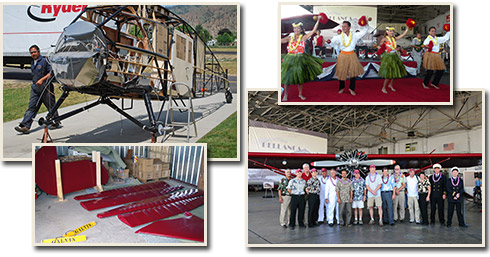
The Pacemaker’s wing struts are a uniquely Bellanca innovation. These fabric-covered, high-aspect-ratio “wings” add 47 square feet of lifting area and greatly improve lateral stability, because of their extreme “dihedral.”
 It takes a while to taxi from the Bellanca’s hangar to the threshold of Honolulu’s Runway 4R, which is good. It gave the oil a chance to warm—this always takes longer in a radial engine—and gave me a chance to get used to the brakes, which are, well, weird.
It takes a while to taxi from the Bellanca’s hangar to the threshold of Honolulu’s Runway 4R, which is good. It gave the oil a chance to warm—this always takes longer in a radial engine—and gave me a chance to get used to the brakes, which are, well, weird.
The Pacemaker has heel brakes but not like those found on an Aeronca 7AC Champion or a Piper J–3 Cub. The rudder pedals look conventional, but you push on the bottoms of the pedals with your heels to activate the brakes and push against the tops with your toes for steering. This takes some getting used to. It is important to remember to raise your feet off the floor during takeoff and landing so as not to inadvertently drag the brakes. I made that mistake during my first takeoff. The good news is that the brakes are not strong or grabby, and you don’t have to worry about causing a nose-over. When taxiing in a stiff crosswind, though, you might have to make a 270-degree turn in the wrong direction to make a 90-degree turn in the other. (A tailwheel lock is engaged during takeoff and landing to help keep the airplane on the straight and narrow.)
Pushing the throttle of the Pratt & Whitney radial unleashes a thundering crescendo of power that urged the lightly loaded Bellanca to climb eagerly into the warm Hawaiian trade winds.
The airplane is loud, and noise-cancelling headsets are a must, which makes one wonder how pioneer pilots ever managed to salvage any of their hearing. The airplane is noisy from the outside, too. Hawaiian Airlines produced a video that shows one of its new Airbus A330-200s flying slowly past the diving-at-full-power Bellanca. The Airbus pilots reported that they could actually hear the Bellanca from inside their soundproofed cockpit. (The Hawaiian Airlines’ logo emblazoned on the tails of their jetliners is called Pualani, a female name that loosely translated means “flower of the sky.”)
Although the Bellanca has six seats, it rarely is flown with that many people because this can cause the pilot to run out of nose-down trim. The trim crank is on the cockpit ceiling and is reminiscent of the trim handle found in some of the older Piper aircraft in which you always had to first think about which way to turn the handle. There was nothing intuitive about it. Dunkerley advised me to “just crank it, and if that happens to be in the wrong direction, quickly trim it the other way.” (When looking up at the cockpit ceiling, a clockwise rotation of the handle provides nose-up trim, and vice versa.) There is no placard to offer assistance as there are in Piper aircraft.
Even when in trim, stick forces in the Bellanca are heavier than in a Stear-man but the airplane exhibits about as much adverse yaw. Adroit use of rudder is needed to prevent slipping and skidding. The Pacemaker also is a bit slow to respond in roll, probably because of the significant roll damping imposed by its large wings.
The Bellanca’s nose doesn’t pitch down much during a stall. The airplane simply descends in a relatively nose-high, mushing attitude while the control stick is held fully aft. There is some rolling tendency, but the rudder easily keeps this in check.
The recommended method of approach for landing is to come in high and with the nose down. A flat, nose-high, power-on approach makes it difficult to see over the nose, and a slip is needed to keep the runway in sight. Dunkerley recommends 80 mph on final and 70 mph over the fence.
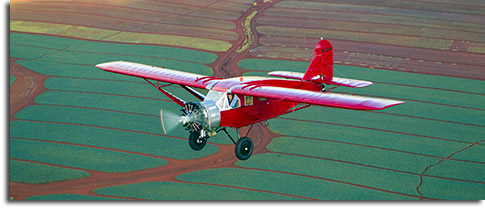
Following my offshore air work near Koko Head Crater, we flew to Kalaeloa, a joint-use airport on the south shore of Oahu where I had an opportunity to make a series of stop-and-go landings. General aviation pilots have been allowed to use this Coast Guard facility ever since Ford Island was closed as an airport in 1999.
We then returned to Honolulu International where I observed with renewed amazement the ability of air traffic controllers there to seamlessly blend an extraordinary mix of traffic. At any given time there can be students in the traffic pattern, military fighters, an incessant stream of airline traffic, and perhaps a fatigued GA pilot approaching the airport at the end of a long and lonely ferry flight from California.
The Bellanca is now used to take aloft every Hawaiian Airlines’ employee and retiree who so desires. “This is a very popular program. So far, the Bellanca has given rides to almost 500 of our people, and they are encouraged to invite family members and friends to come along,” Dunkerley says. Some employees never know before their flights that their captain might be the company CEO.
“I enjoy operating some of these sightseeing flights. It is a genuine privilege for me to take our people for rides over Oahu.” He then adds, “We don’t just celebrate history here; we fly it.”
